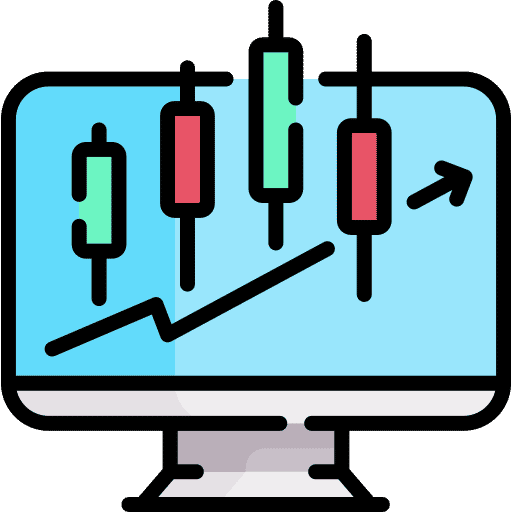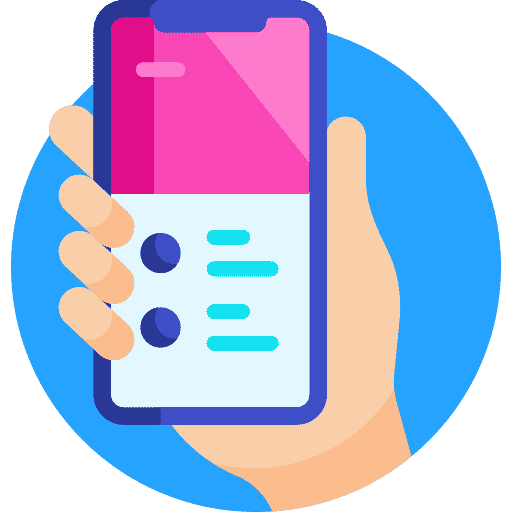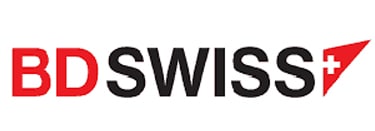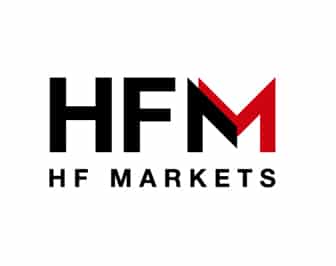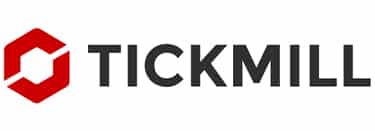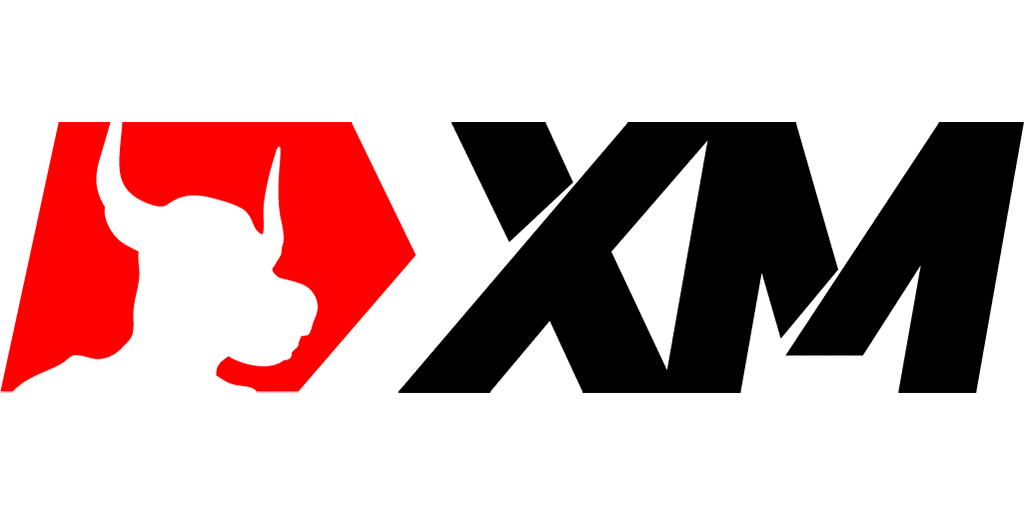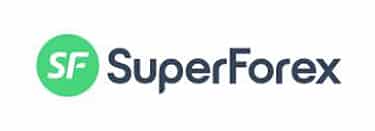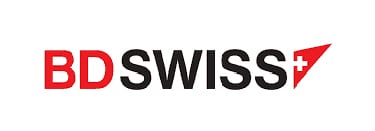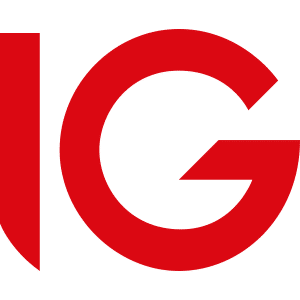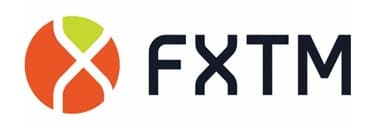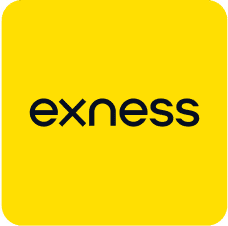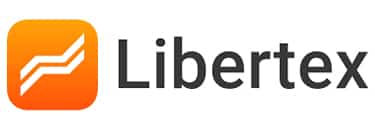
- Fully Regulated
- Expertly Reviewed
- Secure & Trusted
- Transparent Fees
- Mobile Friendly
Find The Best Broker For Your Trading Level.
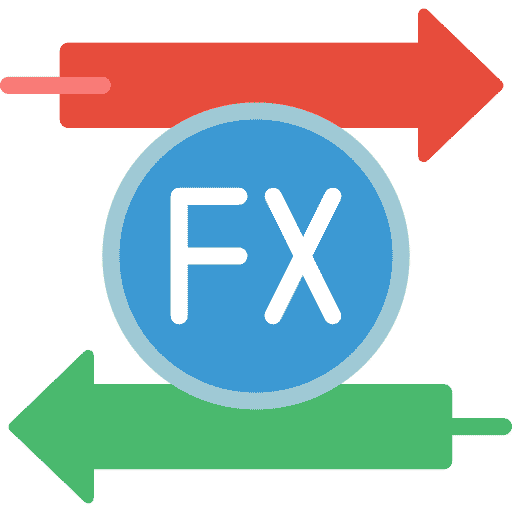
NASDAQ forex Brokers
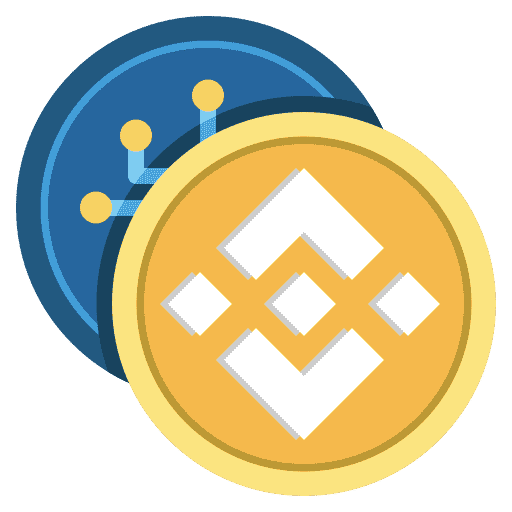
Cryptocurrency Trading platforms
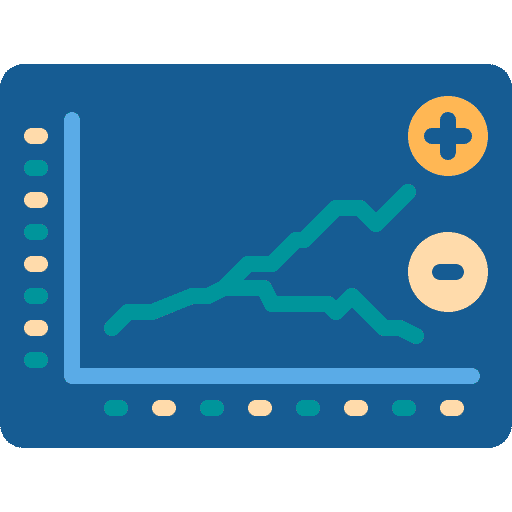
Volitality 75 Forex Brokers
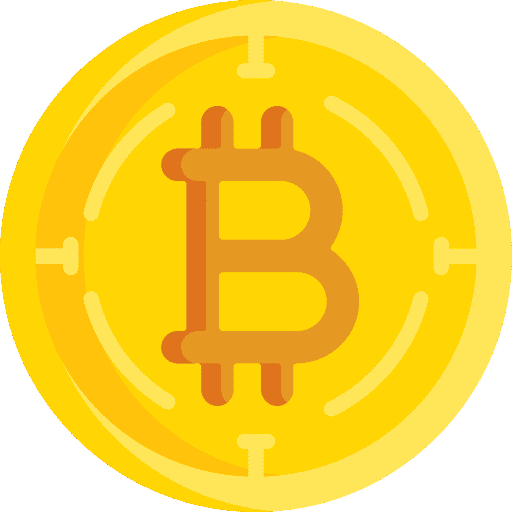
How to Buy Bitcoin
Forex Trading Brokers in Indonesia
Indonesia is an increasingly prosperous market in Southeast Asia, experiencing a substantial rise in forex trading. Boasting a multifaceted economy and stringent regulations, the nation’s forex sector presents exclusive prospects for traders and investors.
Quick Content

Pros and Cons of Forex Trading

How to Start Trading in Indonesia?

Currency Pairs

Forex Trading Basics

Forex Terminology

Forex Charting

Forex Trading Risk Management

Forex Trading Strategies
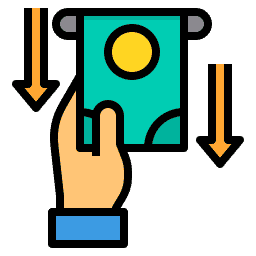
Forex Trading Platforms
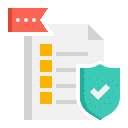
Best Forex Brokers in Indonesia
Quick Content

Pros and Cons of Forex Trading

How to Start Trading in Namibia?

Currency Pairs

Forex Trading Basics

Forex Terminology

Forex Charting

Forex Trading Risk Management

Forex Trading Strategies

Forex Trading Platforms

Best Forex Brokers in Namibia
Top 10 Best Forex Brokers in Indonesia
| 🥇 Forex Broker | 🎉 Open An Account | 🤝 Accepts Indonesians | 📝 Regulation | 💻 Max Leverage | 💰 Min Deposit |
| 1. Exness | Open Account | Yes | FSA, CBCS, FSC, FSC BVI, FSCA, CySEC, FCA, CMA | Unlimited | 10 USD / 157,151 IDR |
| 2. RoboForex | Open Account | Yes | CySEC, IFSC, Labuan FSA | 1:2000 | 10 USD / 157,151 IDR |
| 3. GO Markets | Open Account | Yes | ASIC, FSA Seychelles, FSC Mauritius, CySEC | 1:500 | 200 AUD / 2,010,016 IDR |
| 4. Tickmill | Open Account | Yes | FSA, FCA, CySEC, Labuan FSA, FSCA | 1:500 | 100 USD / 1,571,515 IDR |
| 5. Pepperstone | Open Account | Yes | ASIC, BaFin, CMA, CySEC, DFSA, FCA, SCB | 1:500 (Pro) 1:200 (Retail) | 200 AUD / 2,010,016 IDR |
| 6. AvaTrade | Open Account | Yes | CBI, BVI FSC, ASIC, FSCA, JFSA, FFAJ, ADGM, CySEC, ISA, KNF, IIROC | 1:30 (Retail) 1:400 (Pro) | 100 USD / 1,571,515 IDR |
| 7. Axi | Open Account | Yes | ASIC, SVG FSA, FCA, FMA, DFSA | 1:500 | 0 USD / 0 IDR |
| 8. Windsor Brokers | Open Account | Yes | FSC, CySEC, JSC, FSA, CMA | 1:500 | 100 USD / 1,571,515 IDR |
| 9. HFM | Open Account | Yes | FSCA, CySEC, DFSA, FSA, FCA, FSC, CMA | 1:2000 | 0 USD / 0 IDR |
| 10. easyMarkets | Open Account | Yes | BVI FSC, CySEC, ASIC, FSA | 1:400 | 25 USD / 392,878 IDR |
Top 10 Forex Brokers
Broker
Rating
Regulators
Min Deposit
Leverage
Website
Top 10 Forex Brokers
Broker
Rating
Min Deposit
Leverage
What is Forex Brokers?
Forex brokers are financial firms that facilitate the trading of foreign exchange (forex) currencies for individuals. These brokers offer trading platforms and tools that allow traders to buy and sell various currency pairs.
They offer services such as real-time price quotes, charting tools, technical analysis, and access to leverage. Forex brokers play a crucial role in providing traders with the necessary infrastructure to engage in currency trading.
In this comprehensive guide, you’ll learn all you need to know about being a great trader and which forex brokers in Indonesia are best suited for your trading style. Indonesian traders can easily start earning profits from the competitive, exciting environment of forex trading.





How profitable is Forex trading for individuals and retail traders? How much do you need to start trading Forex in Indonesia? Can you keep your full-time job while you trade Forex part-time? What are the significant risks involved with trading Forex in Indonesia?
These are just a few questions that many Indonesian traders may have as beginner forex traders. Explore our website to find the answers to these questions and more.
BAPPEBTI, often known as the Commodity Futures Trading Regulatory Agency, is an agency of the Indonesian Ministry of Trade. It is in charge of regulating and monitoring commodities futures transactions, including Forex trading.
BAPPEBTI guarantees that brokers follow the rules, provide clear information about their products and services, and provide proper investor protection.
While the BAPPEBTI does not officially regulate forex brokers who carry out financial activities, regulators such as the FSCA, FCA, CySEC, and others protect Indonesians.
We reveal the best brokers with verified regulations who offer their services locally in Indonesia. Indonesians can rest assured that these are trusted and legitimate brokers that garner a high trust score or rating.
Forex Trading Pros and Cons
| ✔️ Pros | ❌ Cons |
| Strong government oversight ensures safety in Indonesia | Limited access in remote areas in Indonesia, especially rural areas |
| Many local and international brokers welcome Indonesian traders and support IDR | Currency volatility due to local factors, including political issues |
| Growing economy offers opportunities in Indonesia | Internet connectivity issues in some areas in Indonesia, preventing many from trading forex |
| 24-hour market access 5 days a week | Language barriers with international brokers as not all have customer support or websites in Indonesian |
| Advanced trading platforms available to more experienced traders | Inconsistent regulation in some countries |
| Leverage options are available across several markets | Technology failures can disrupt trading |
| Increasing technological advancements ensure that traders have a competitive edge | Steep learning curve for beginners |
| Growing community and educational resources to help beginners start trading | |
| Abundant educational resources offered by several brokers |
Step-by-Step on How to Start Trading Forex in Indonesia
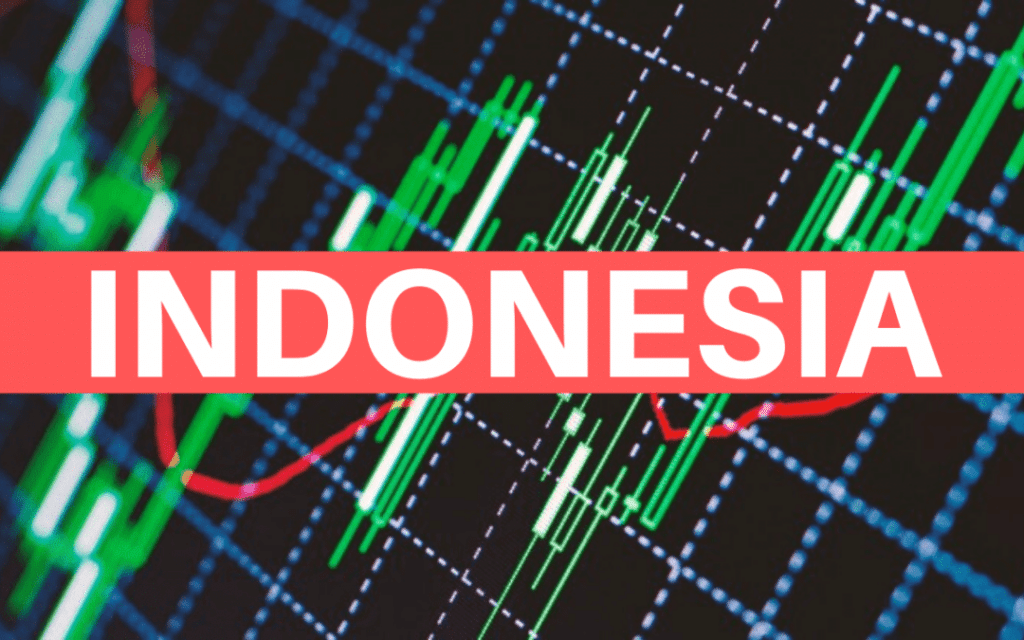










Before commencing this financial endeavour, gaining a thorough understanding of the notion of forex trading is critical.
Forex trading is the exchange of different currencies against one another in the worldwide foreign exchange market, which has a staggering daily trading volume of more than $6 trillion.
Traders attempt to forecast currency exchange rate swings to profit. Many learning tools, such as online courses, e-books, and articles, are readily available to help in this educational endeavour.

A full understanding of important terminologies used in forex trading is required to navigate this market competently. These are some of the terms:






Obtaining practical experience through a demo account is prudent before committing genuine funds.
This risk-free simulation helps ambitious traders become acquainted with the trading platform, perfect their abilities, and understand the complexities of forex trading. When choosing a brokerage, it is critical to consider regulation, user-friendly interfaces, and great customer service.

Forex trading entails inherent dangers, notably potential financial losses due to market volatility, leverage utilization, and insufficient trading competence. Traders must understand and successfully manage these risks, using stop-loss orders to limit possible losses.

Forex trading employs a variety of trading strategies, each catering to different trading objectives and risk tolerance levels:



Each technique has advantages and disadvantages; the best relies on personal tastes and goals.

Leverage the demo account as a valuable tool for experimenting with and honing your newly developed trading strategies. This hands-on experience will provide invaluable insights into the functionality of these tactics under real-world market conditions.

Once aspiring traders have cultivated a sense of confidence in their trading methods and acquired a profound understanding of the associated risks, they can confidently take the next step and open an authentic trading account.
To approach this endeavour prudently, it is advisable to commence with conservative investments and progressively amplify them as one’s expertise and market knowledge grow.

Choosing an appropriate trading platform is critical to ensure a smooth trading experience. MetaTrader 4 and MetaTrader 5 are two prominent solutions offering cutting-edge charting features, market indicators, and automated trading capabilities.
When making this essential decision, consider usability, features, and compatibility.

After creating the account, traders can fund it and begin their trading trip. Bank transfers, credit cards, and electronic wallets are common deposit methods reputable brokers use. It is critical to closely monitor deals and avoid investing cash above one’s financial capacity.
4 Best Currency Pairs for Beginner Indonesians to Trade
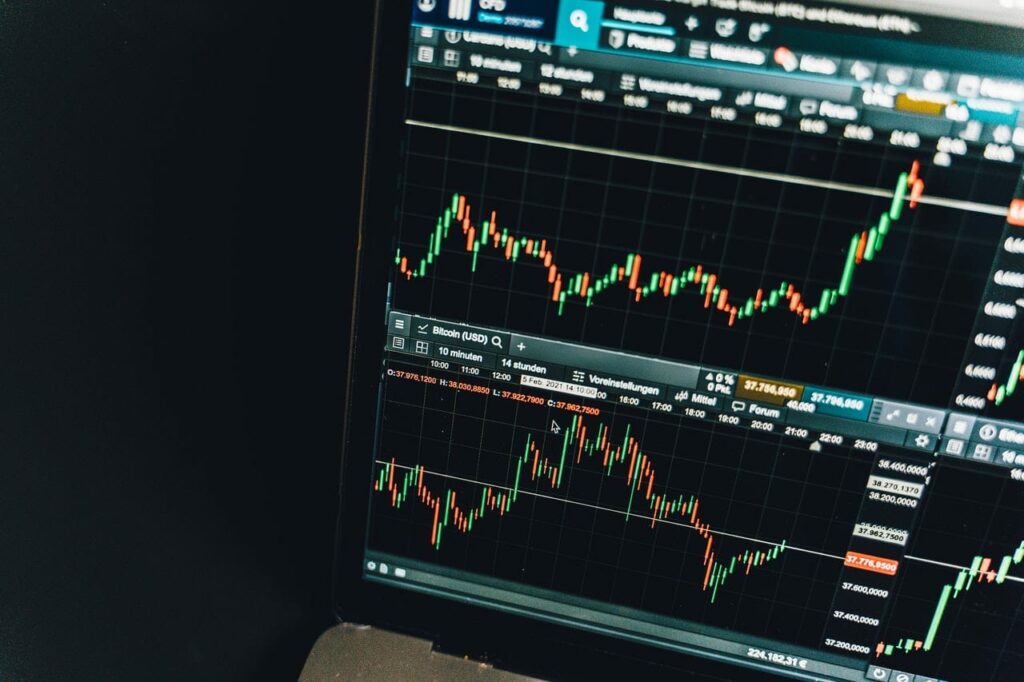
USD/JPY (US Dollar/Japanese Yen)
The USD/JPY pair might be an ideal starting point for new traders in Indonesia. This pair represents the exchange rate between the US dollar and the Japanese yen.
Because the US dollar is a prominent worldwide currency and Japan is a major trading partner of Indonesia, information and analysis on this pair are widely available. The USD/JPY currency pair has low volatility, making it good for inexperienced forex traders.
EUR/USD (Euro/US Dollar)
The EUR/USD currency pair is highly recommended for newbies as it represents the Euro and US Dollar exchange rates. Due to their significant roles in the global economy, economic events occurring in both regions can significantly affect this particular currency pairing.
Beginners should primarily focus on familiar currencies and worldwide economic matters while trading EUR/USD.
Understanding key factors such as the European Central Bank’s policies, the Federal Reserve’s initiatives, and notable economic indicators can greatly influence one’s trading decisions.
AUD/USD (Australian Dollar/US Dollar)
The currency pair AUD/USD represents the Australian and US Dollars. This pair may be more predictable for Indonesian newcomers because of Australia’s close physical and economic ties with the Asia-Pacific region.
Commodity prices, interest rates, and trade agreements between Australia and other countries can all impact the AUD/USD exchange. Following global economic news and regional trends might assist rookie traders in making sound trading judgments.
GBP/USD (British Pound/US Dollar)
The “Cable” currency pair indicates the British Pound and the US Dollar exchange rate. This pair is appropriate for novices because of its high liquidity and thorough research and information.
Indonesian traders can trade this pair by observing UK economic indicators, Bank of England decisions, and US economic situations. The GBP/USD currency pair can show distinct trends and is influenced by factors such as interest rates, political changes, and global economic events.
4 Best Currency Pairs for Professional Indonesians to Trade

USD/JPY (US Dollar/Japanese Yen)
The USD/JPY pair provides opportunities for more complex strategies for professional traders in Indonesia. This significant currency pair is highly liquid and is susceptible to global economic events, interest rate differentials, and geopolitical tensions.
Professional traders can trade the USD/JPY using technical analysis, macroeconomic trends, and global market insights. Its increased volatility may present greater profit opportunities but requires prudent risk management.
EUR/USD (Euro/US Dollar)
The EUR/USD is one of the most actively traded currency pairs worldwide and provides professionals in Indonesia with access to the global forex market. Both Eurozone and US economic indicators influence this currency combination.
Understanding global economic trends, interest rate policies, and geopolitical events is necessary for trading the EUR/USD. Professional traders can use sophisticated trading strategies and financial instruments to profit from this pair’s movements.
GBP/USD (British Pound/US Dollar)
The GBP/USD currency pair indicates the exchange rate between the British Pound and the United States Dollar. It is a popular option among professional traders due to its liquidity and sensitivity to economic news from both the United Kingdom and the United States.
Professional traders can trade this pair by analyzing UK economic indicators, Bank of England decisions, and US economic conditions. The GBP/USD may present dynamic trading opportunities during significant economic announcements.
USD/CHF (US Dollar/Swiss Franc)
The stability of the USD/CHF currency exchange is widely recognized, earning it a reputation as a secure and dependable choice for traders seeking a safe haven.
In Indonesia, professional traders can trade this currency pair to enhance their portfolio diversification and minimize risks associated with market instability.
Several factors influence the decision-making process when trading this particular pair. These include staying informed about Swiss economic policies, monitoring global risk sentiment, and assessing US economic conditions.
By being aware of these elements that impact the USD/CHF currency pair’s performance, professionals can seize opportunities while managing potential volatility effectively.
With its unique blend of stability and profit potential capabilities combined within one pairing option, the USD/CHF suits skilled individuals who aim to mitigate risks through effective management strategies and maximize financial gains.
9 Best No-Deposit Forex Brokers in Indonesia
1. InstaForex
Min Deposit
1 USD / 15,715 IDR
Regulators
BVI FSC, CySEC, FSA SVG, FCA
Trading Desk
MetaTrader 4, MetaTrader 5, WebIFX, InstaForex Multi-Terminal, InstaForex WebTrader, InstaTick Trader, InstaForex MobileTrader
Crypto
Total Pairs
4
Islamic Account
Trading Fees
Account Activation
InstaForex offers a significant $1,000 no-deposit incentive to new clients in Indonesia. The bonus is promptly credited upon completion of account verification, allowing for quick trading.
InstaForex Overview
| 🔎 Broker | InstaForex |
| 📝 Regulation | BVI FSC, CySEC, FSA SVG, FCA |
| 💻 Trading Desk | MetaTrader 4, MetaTrader 5, WebIFX, InstaForex Multi-Terminal, InstaForex WebTrader, InstaTick Trader, InstaForex MobileTrader |
| 🎉 No Deposit Bonus | 1,000 USD / 15,706,000 IDR |
| ➖ Min. Deposit from | 1 USD / 15,715 IDR |
| 🔁 Spreads from | from 0 pips |
| ➕ Max Leverage | 1:1-1:1000 |
| 💳 Commission | 0.03% – 0.07% |
| 🚀 Open an Account | Open Account |
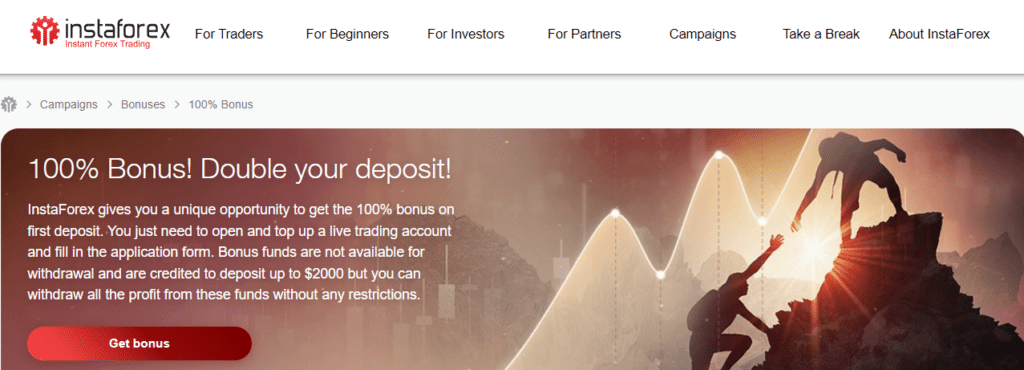
Pros and Cons
| ✔️ Pros | ❌ Cons |
| The $1,000 is extremely generous | The bonus is non-withdrawable and will expire when traders make their first withdrawal |
| Traders can withdraw profits they make over the bonus amount | Account verification can be complex |
| Indonesians can access a large range of trading tools and education | |
| Offers powerful trading software |
2. Admirals
Min Deposit
1 USD / 15,553 IDR
Regulators
FCA, ASIC, CySEC, JSC, FSCA, FSA, CMA
Trading Desk
MetaTrader 4, MetaTrader 5, Admirals Mobile App
Crypto
Total Pairs
82+
Islamic Account
Trading Fees
Account Activation
Admirals, formerly Admiral Markets, offers Indonesian traders a 100 USD “Special Bonus.” This bonus, valid for 30 days after receipt, improves trading by increasing available margin but does not compensate for trading losses.
Each trading account can only have one active bonus and specified trading volume requirements must be completed to withdraw or transfer funds. The Admirals’ bonus is a well-structured program that encourages careful trading.
Admirals Overview
| 🔎 Broker | Admiral Markets |
| 📝 Regulation | FCA, ASIC, CySEC, JSC, FSCA, FSA, CMA |
| 💻 Trading Desk | MetaTrader 4, MetaTrader 5, Admirals Mobile App |
| 🎉 No Deposit Bonus | 100 USD / 1,570,600 IDR |
| ➖ Min. Deposit from | 1 USD / 15,553 IDR |
| 🔁 Spreads from | 0.0 |
| ➕ Max Leverage | 1:1000 |
| 💳 Commission | Stocks & ETFs – from 0.02 USD per share |
| 🚀 Open an Account | Open Account |

Pros and Cons
| ✔️ Pros | ❌ Cons |
| Admirals is a trusted and well-regulated broker | Traders cannot use the bonus to offset losses |
| Indonesians can increase their margin for trading using the bonus | The bonus is only available for 30 days |
| There is a generous 100 USD no-deposit bonus offered with a decent validity period | There are strict requirements in place for withdrawals and internal transfers |
3. Tickmill
Min Deposit
100 USD / 1,555,300 IDR
Regulators
Seychelles FSA, FCA, CySEC, Labuan FSA, FSCA
Trading Desk
MT4, MT5, Tickmill Mobile
Crypto
Total Pairs
62
Islamic Account
Trading Fees
Account Activation
Tickmill, a well-known broker, offers a $30 Welcome Account to all new clients, including Indonesians. With this incentive, traders get access to a wide range of trading products, including Forex, stock indices, commodities, and bonds.
The withdrawal procedure is simple, requiring the completion of 5 standard lots and 20 round turn trades. Tickmill’s compensation system is geared toward novice and seasoned traders who want to experiment with different markets without making initial investments.
Tickmill Overview
| 🔎 Broker | Tickmill |
| 📝 Regulation | Seychelles FSA, FCA, CySEC, Labuan FSA, FSCA |
| 💻 Trading Desk | MT4, MT5, Tickmill Mobile |
| 🎉 No Deposit Bonus | 30 USD / 471,180 IDR |
| ➖ Min. Deposit from | 100 USD / 1,555,300 IDR |
| 🔁 Spreads from | 0 pips |
| ➕ Max Leverage | 1:500 |
| 💳 Commission | 2 per side per 100,000 traded |
| 🚀 Open an Account | Open Account |
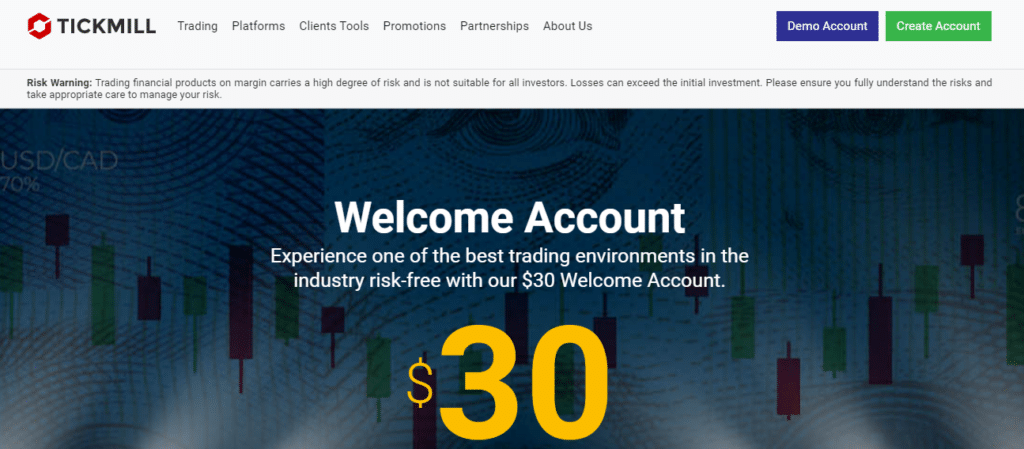
Pros and Cons
| ✔️ Pros | ❌ Cons |
| All new clients are eligible for the 30 USD no-deposit bonus | Traders must trade at least 5 standard lots and 20 round-turn trades to be able to withdraw their bonus |
| Tickmill has transparent withdrawal conditions | There are limited bonus offerings when compared to other brokers |
| Several asset classes can be traded |
4. XM
Min Deposit
5 USD / 78,575 IDR
Regulators
FSCA, IFSC, ASIC, CySEC, DFSA
Trading Desk
MetaTrader 4, MetaTrader 5, XM Mobile App
Crypto
No
Total Pairs
57
Islamic Account
Trading Fees
No (Just spread)
Account Activation
XM, a worldwide famous broker, provides new clients with a $30 no-deposit bonus. This offer is instantly credited without requiring a deposit, but withdrawing the bonus and any associated winnings requires trading at least 5 standard lots.
This offer is intended to attract new traders and provide an opportunity to learn about the trading environment at XM.
XM Overview
| 🔎 Broker | XM |
| 📝 Regulation | FSCA, IFSC, ASIC, CySEC, DFSA |
| 💻 Trading Desk | MetaTrader 4, MetaTrader 5, XM Mobile App |
| 🎉 No Deposit Bonus | 30 USD / 471,180 IDR |
| ➖ Min. Deposit from | 5 USD / 78,575 IDR |
| 🔁 Spreads from | 0 pips |
| ➕ Max Leverage | 1000:1 |
| 💳 Commission | None |
| 🚀 Open an Account | Open Account |
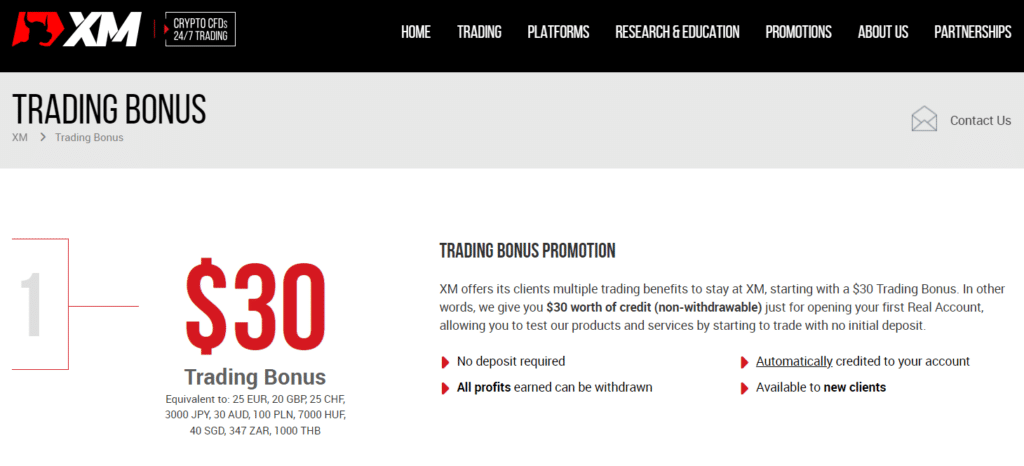
Pros and Cons
| ✔️ Pros | ❌ Cons |
| Newly registered traders get 30 USD once they verify a trading account | Specific regions are restricted from service |
| XM offers user-friendly programs and a large range of instruments | There is a high 5 standard lot trading volume requirement to withdraw the bonus |
| XM has an extremely strong regulatory framework |
5. SuperForex
Min Deposit
1 USD / 15,715 IDR
Regulators
None
Trading Desk
MetaTrader 4, SuperForex App
Crypto
Total Pairs
300
Islamic Account
Trading Fees
Account Activation
SuperForex’s no-deposit bonus of 88 USD is available to all qualified clients and covers various account types.
This incentive gives flexibility and encourages continuing involvement by having no predetermined expiration date and the ability to collect the bonus again under specific conditions.
SuperForex Overview
| 🔎 Broker | SuperForex |
| 📝 Regulation | None |
| 💻 Trading Desk | MetaTrader 4, SuperForex App |
| 🎉 No Deposit Bonus | 88 USD / 1,382,128 IDR |
| ➖ Min. Deposit from | 1 USD / 15,715 IDR |
| 🔁 Spreads from | 0.5pips |
| ➕ Max Leverage | 1:1000 |
| 💳 Commission | 1% – 5% plus additional fees |
| 🚀 Open an Account | Open Account |

Pros and Cons
| ✔️ Pros | ❌ Cons |
| SuperForex is a trusted broker with robust customer support | The bonus is limited to new Prime Accounts |
| There is a 30 USD no-deposit bonus offered to all new live trading accounts | There are limited trading platforms compared to other brokers |
| Traders can register a multi-currency account |
6. ForexChief
Min Deposit
10 USD / 157,151 IDR
Regulators
VFSA
Trading Desk
MetaTrader 4, MetaTrader 5
Crypto
Total Pairs
150+
Islamic Account
Trading Fees
Account Activation
The $100 no-deposit incentive from ForexChief provides an excellent opportunity for Indonesian traders to evaluate services and trading tactics.
A quick verification process, an infinite duration, acceptance of all trading techniques, and an easy withdrawal process for the bonus and winnings are among the key advantages.
The bonus structure is intended to give the best combination of flexibility and incentive for both novice and experienced traders.
ForexChief Overview
| 🔎 Broker | ForexChief |
| 📝 Regulation | VFSA |
| 💻 Trading Desk | MetaTrader 4, MetaTrader 5 |
| 🎉 No Deposit Bonus | 100 USD / 1,570,600 IDR |
| ➖ Min. Deposit from | 10 USD / 157,151 IDR |
| 🔁 Spreads from | from 0.9 pips |
| ➕ Max Leverage | 1:1000 |
| 💳 Commission | $2.5 / €2.5 / £2.5 |
| 🚀 Open an Account | Open Account |
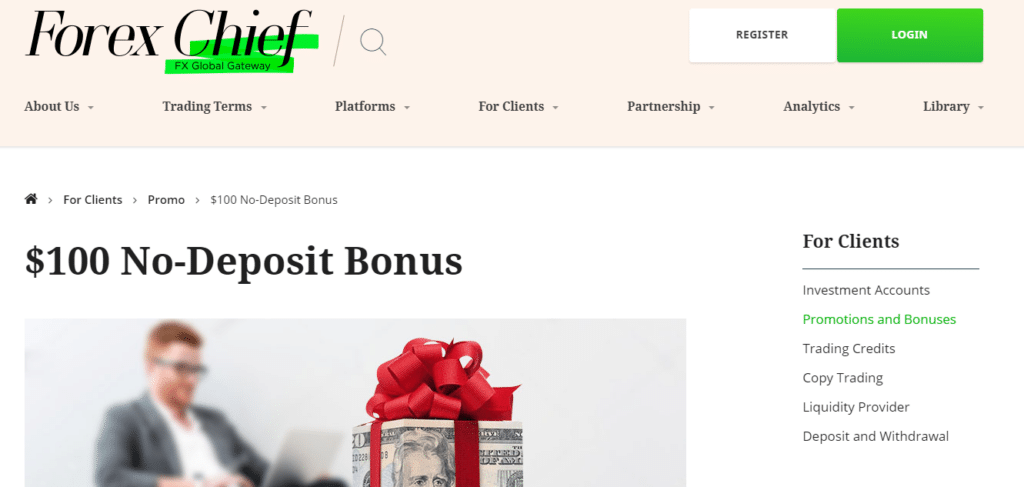
Pros and Cons
| ✔️ Pros | ❌ Cons |
| Traders can use the ForexChief app to trade from anywhere | There is a complex procedure to withdraw the no-deposit bonus |
| There are no restrictions on trading strategies | |
| Traders can get a 100 USD no-deposit bonus that does not expire |
7. JustMarkets
Min Deposit
10 USD / 156,953 IDR
Regulators
FSA
Trading Desk
MetaTrader 4, MetaTrader 5, JustMarkets App
Crypto
Total Pairs
240+
Islamic Account
Trading Fees
Account Activation
JustMarkets caters particularly to Indonesian traders, offering a $30 Welcome Bonus via their unique “Welcome Account.” It offers trading in forex currency pairs and commodities denominated in USD to new clients and is limited to one bonus per client.
The bonus promotes a safe trading environment, encouraging users to explore the platform. Multiple bonus accounts are prohibited by strict restrictions, assuring fairness for all clients.
JustMarkets Overview
| 🔎 Broker | JustMarkets |
| 📝 Regulation | FSA |
| 💻 Trading Desk | MetaTrader 4, MetaTrader 5, JustMarkets App |
| 🎉 No Deposit Bonus | 30 USD / 471,180 IDR |
| ➖ Min. Deposit from | 10 USD / 156,953 IDR |
| 🔁 Spreads from | 0.3 pips |
| ➕ Max Leverage | 1:3000 |
| 💳 Commission | None |
| 🚀 Open an Account | Open Account |
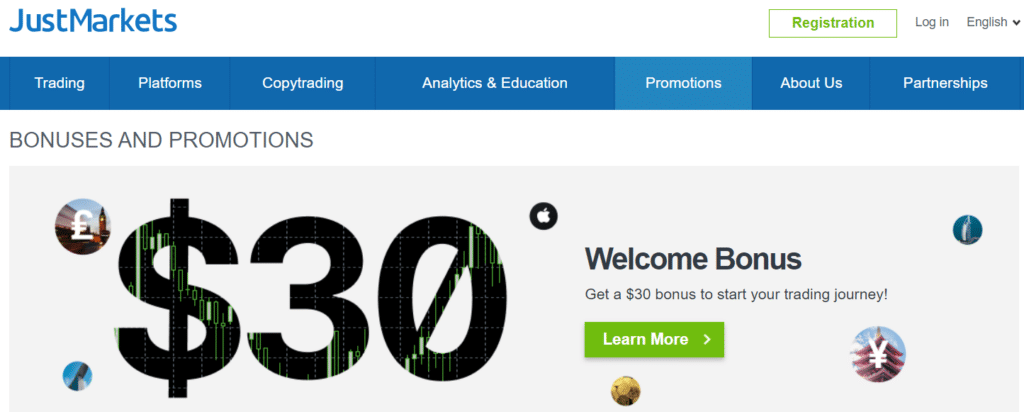
Pros and Cons
| ✔️ Pros | ❌ Cons |
| Indonesians receive a 30 USD no-deposit bonus when they register | Only one welcome account allowed per client |
| Traders can register flexible trading accounts | There are limited markets to trade |
| JustMarkets has clear guidelines and bonus eligibility |
8. FreshForex
Min Deposit
0 USD / 0 IDR
Regulators
SVG ,FSA
Trading Desk
MetaTrader 4, MetaTrader 5
Crypto
Total Pairs
52+
Islamic Account
Trading Fees
Account Activation
FreshForex’s innovative approach to no-deposit bonuses provides Indonesians with a 99 USD offer focusing on profit preservation within 7 calendar days.
The terms allow traders to protect their earnings by depositing an amount equal to or greater than their profits. FreshForex’s no-deposit bonus stands out in the market, catering to traders searching for a quick boost to their trading capital.
FreshForex Overview
| 🔎 Broker | FreshForex |
| 📝 Regulation | SVG ,FSA |
| 💻 Trading Desk | MetaTrader 4, MetaTrader 5 |
| 🎉 No Deposit Bonus | 99 USD / 1,554,894 IDR |
| ➖ Min. Deposit from | 0 USD / 0 IDR |
| 🔁 Spreads from | 0 pips |
| ➕ Max Leverage | 1:2000 |
| 💳 Commission | From 0.003% per contract |
| 🚀 Open an Account | Open Account |

Pros and Cons
| ✔️ Pros | ❌ Cons |
| FreshForex has competitive trading conditions and decent leverage ratios | There is a limited 7-day period tied to the bonus |
| FreshForex has prompt and friendly customer support | Traders must deposit or exceed the deposit with profits to keep it |
| Indonesians can earn a 99 USD no-deposit bonus when they register an account |
9. Windsor Brokers
Min Deposit
50 USD / 785,300 IDR
Regulators
FSC, CySEC, JSC, FSA, CMA
Trading Desk
MetaTrader 4, Windsor Brokers App
Crypto
Total Pairs
50+
Islamic Account
Trading Fees
Account Activation
New Prime Account clients at Windsor Brokers can avail themselves of a convenient $30 no-deposit bonus. Upon acceptance, the account receives free trading credit once the registration steps are completed.
This promotional offer is open to individuals in various currencies. It aims to provide an inviting atmosphere for beginners interested in real trading without any initial financial commitment.
Windsor Brokers Overview
| 🔎 Broker | Windsor Brokers |
| 📝 Regulation | FSC, CySEC, JSC, FSA, CMA |
| 💻 Trading Desk | MetaTrader 4, Windsor Brokers App |
| 🎉 No Deposit Bonus | 30 USD / 471,180 IDR |
| ➖ Min. Deposit from | 50 USD / 785,757 IDR |
| 🔁 Spreads from | 0 pips |
| ➕ Max Leverage | 1:1000 |
| 💳 Commission | $8 commission round turn |
| 🚀 Open an Account | Open Account |
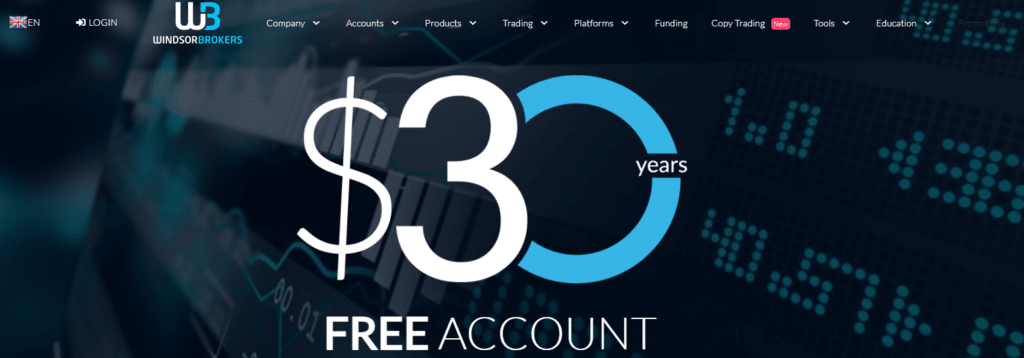
Pros and Cons
| ✔️ Pros | ❌ Cons |
| Windsor Brokers is a trusted broker with robust customer support | The bonus is limited to new Prime Accounts |
| There is a 30 USD no-deposit bonus offered to all new live trading accounts | There are limited trading platforms compared to other brokers |
| Traders can register a multi-currency account |
Forex Trading – Stock Trading – Cryptocurrency Trading Compared
| 💸 Forex Trading | 📉 Stock Trading | ₿ Crypto Trading | |
| ⏰ Market Hours | 24/5 | 9 am – 3 pm (GMT+3) Monday to Friday | 24/7 |
| 🚅 Trading Speed | Instant | Slow | Instant |
| 💰 How is it traded? | OTC | Exchanges | OTC/Exchanges |
| 📊 Price Fluctuation | Fast | Slow | Fast |
| ➖ Min. Trade Size | 0.01 lots | 1 share or fractions | 1 share or fractions |
| ⬆️ Volatility | High | Low | High |
| 💧 Liquidity | Very High | Blue Chip Stocks are the most liquid | Only major crypto, e.g. BTC, ETH, LTC, DOGE, etc. |
| 🔊 Trading Volume | High | High | Medium |
| ⚖️ Regulation | $6.6 Trillion | 7,369,200 | $500 Billion+ |
| 💵 Investment Horizon | Short, Medium, Long-Term | Medium and Long-Term | Short, Medium, Long-Term |
| 📈 Average Leverage Ratios | 1:100 – 1:3000+ | <1:100 | <1:10 |
| ✔️ Susceptibility to Macroeconomic Factors | Yes Rarely as turbulent as Crypto | Yes Economic Performance | Yes Consumer Behaviour Supply and Demand |
5 Most Successful Forex Traders in Indonesia

Denny Omar
Denny Omar’s journey to trading success illustrates the strength of perseverance and a love of the financial markets. Despite having no professional expertise in finance or economics, he began FX trading as a self-taught man in 2005.
Denny’s outstanding work ethic and readiness to learn from mistakes have propelled him to the top of Indonesia’s trading ranks. His dedication to self-improvement and adaptation in the face of adversity is an example for prospective traders joining the business.
Eka Lesmana
With over 15 years of trading expertise, Eka Lesmana is well-known for his remarkable technical analysis abilities and keen ability to discover successful trading chances. His unwavering dedication to remaining current on market trends and the news keeps him one step ahead of his competitors.
Eka’s extensive trading expertise and deep understanding of market dynamics reinforce his image as an accomplished trader in Indonesia. Furthermore, his ongoing pursuit of information and efficient trading tactics distinguishes him as a significant resource within the trading community.
Sigit Purnomo
Originally from Cilacap, Sigit Purnomo rose to prominence after entering the forex trading industry in 2007. He is well-known for his successful forex trading tactics and emphasis on the importance of mentality in trading success.
Sigit’s insightful views and skills have led to the publication of several well-received forex trading books, further solidifying his name in the trading field. Furthermore, his prominent blog draws many traders who want to benefit from his experiences and knowledge.
Secundo Lee
Originally from Surabaya, Secundo Lee is noted for his distinct “Lazy Trader” trading technique. His methodology is notable for its novel approach to trading systems like Bulletproof, COMMO, and CATS.
Secundo Lee’s expertise and accomplishments culminated in successfully publishing a book that offers significant insights into these trading strategies. His innovative and practical trading style has gained him a big following and the respect of traders across the industry.
Rani Anggraeni
Rani Anggraeni’s success as a female trader in a male-dominated business demonstrates her tenacity and determination. She began her trading profession in 2008 and has become one of Indonesia’s most regarded traders.
Rani’s accomplishments under difficult market situations can be ascribed to her attention to maintaining a clear head and learning emotional control.
Her achievements serve as a role model for aspiring female traders, emphasizing the importance of overcoming hurdles and pursuing one’s passion in the financial markets.
Secrets to the success of these Professional Traders










How to Choose a Forex Broker in Indonesia

Customer Support
Customer service that is responsive guarantees that traders receive prompt assistance and guidance. Traders should look for 24-hour assistance and several communication methods, including chat, email, and phone.
Responsive customer service personnel and support in the local language can improve the trade experience and provide peace of mind.
Client Security and Fund Safety
Security measures to safeguard client information and payments are critical. Traders should seek features like encryption, two-factor authentication, and segregated accounts, which keep customer funds separate from the broker’s operations assets.
Furthermore, trust and confidence are built when a broker prioritizes client security and fund safety.
Regulation and Authorization
When choosing a Forex broker in Indonesia, regulation and permission are critical. Ensuring the broker is regulated by a recognized institution, such as the Financial Conduct Authority (FCA), and others, ensures legal compliance and protects traders from fraudulent activity.
Traders should ensure adequate licensing and conformity to local legislation and foreign regulations, which may apply.
Trading and Non-Trading Fees
Understanding the broker’s fee structure is critical for determining the entire cost of trading. Traders should seek clear information on spreads, commissions, overnight costs, and hidden fees.
A good grasp of trading and non-trading fees enables traders to make informed decisions and choose a competitive broker with optimal pricing.
Education and Research
Individuals can enhance their trading skills and make informed decisions using educational resources and research tools. Traders need to assess the availability of webinars, tutorials, market analysis reports, and research papers.
Brokers who actively invest in education and research foster continuous development among traders by providing ongoing learning opportunities.
Accounts and Features
Different account kinds cater to various trading requirements and preferences. Traders should look for a demo, Standard, ECN, and VIP accounts and comprehend aspects like leverage and margin restrictions.
A broker who selects account types and features enables traders to select the option that best fits their trading style and risk tolerance.
Range of Markets
Access to diverse markets is instrumental in augmenting the trading possibilities and adaptability for traders. Evaluating the presence of various financial instruments, such as currency pairs, commodities, indexes, and other assets, assumes paramount importance for traders.
Opting for brokers offering access to multiple marketplaces empowers traders to explore and implement various trading strategies, unveiling potential opportunities that harmonize with their individual interests and proficiency levels.
Trade Execution and Overall Execution Policy
Efficient and reliable transaction execution minimizes slippage and guarantees favourable pricing.
When selecting a broker, traders need to assess the speed of their execution, policies regarding slippage, and available order types. Opting for a broker with strong execution practices can significantly enhance trading efficiency and profitability.
Online Reviews
Online reviews from other traders might provide useful information about the broker’s reputation and performance.
Reading reviews on independent platforms and focusing on detailed experiences and ratings can assist traders in measuring overall client happiness and making a more informed decision.
Deposit and Withdrawal Options and Speed
Convenient deposit and withdrawal methods ensure that financial transactions run smoothly. Traders should consider the payment options, processing times, and associated fees.
A broker who provides flexible deposit and withdrawal choices and quick processing adds to overall ease and satisfaction.
Trading Platform
A user-friendly and reliable trading platform enhances the overall trading experience. Traders should consider various factors such as platform features, tool availability, mobile compatibility, and customization options.
By opting for a well-crafted trading platform that meets all user requirements, one can make trading endeavours more accessible and enjoyable.
Awards and Recognition
The broker’s industry status and credibility are reflected in awards and recognitions from respectable organizations.
Look for accolades in customer service, innovation, and dependability categories. Awards and recognition can further assure a broker’s competence and reputation.
Before You Start Trading, Read these Few Basics to Forex Trading
What is Forex Trading?
Forex trading, or foreign exchange trading, constitutes buying and selling currencies within the expansive global market. The main aim behind forex trading is to achieve financial profits.
This worldwide renowned financial arena known as Forex highly prioritizes liquidity due to its significance on a global scale. Its primary function involves facilitating currency trades between paired currencies while prevailing exchange rates determine their values.
Currency Pairs
The exchange of currencies occurs in pairs, exemplified by the likes of EUR/USD or GBP/JPY. In currency trading, it is customary to designate the initial currency in a currency pair as the base currency, while the subsequent currency is referred to as the quotation currency.
The value of a currency pair signifies the quantity of the quoted currency required to acquire a single unit of the base currency.
Leverage and Margin
The concepts of leverage and margin are fundamental in financial markets. Leverage refers to using borrowed funds to amplify potential returns on investment.
Using leverage enables traders to exert influence over a substantial position while employing a comparatively modest quantity of cash. It has the potential to increase both financial gains and losses significantly.
Margin refers to the monetary sum that must be present in a trading account to initiate a leveraged position. A comprehensive comprehension of leverage and margin is crucial for effectively mitigating risks in Forex trading.
Trading Platforms
Trading platforms are computer programs that allow traders to conduct transactions, perform market analysis, and manage their accounts effectively. Well-known examples like MetaTrader offer a wide array of tools and functionalities to assist traders in making informed decisions.
Risk Management
Risk management is a systematic process that recognizes, evaluates, and reduces potential risks to minimize adverse consequences while maximizing opportunities.
It entails executing various measures in trading, such as utilizing stop-loss orders, diversifying one’s portfolio, and restricting the amount of money allocated for each transaction to mitigate possible losses.
Demo Accounts
Demo accounts refer to simulated trading environments that allow individuals to practice trading financial instruments without risking real money.
Before engaging in live trading, numerous brokers allow traders to utilize demo accounts, enabling them to practice with simulated funds. This facilitates comprehension of the trading platform and enables the evaluation of methods without incurring any financial risk.
20 Forex Terms You Must Know




















Understanding Forex Charting (with examples)
Forex charting is crucial for traders seeking to analyze currency price movements and identify trading opportunities. This process involves evaluating market trends and patterns using forex charts, indicators, and time frames.
Chart Types
Line Charts
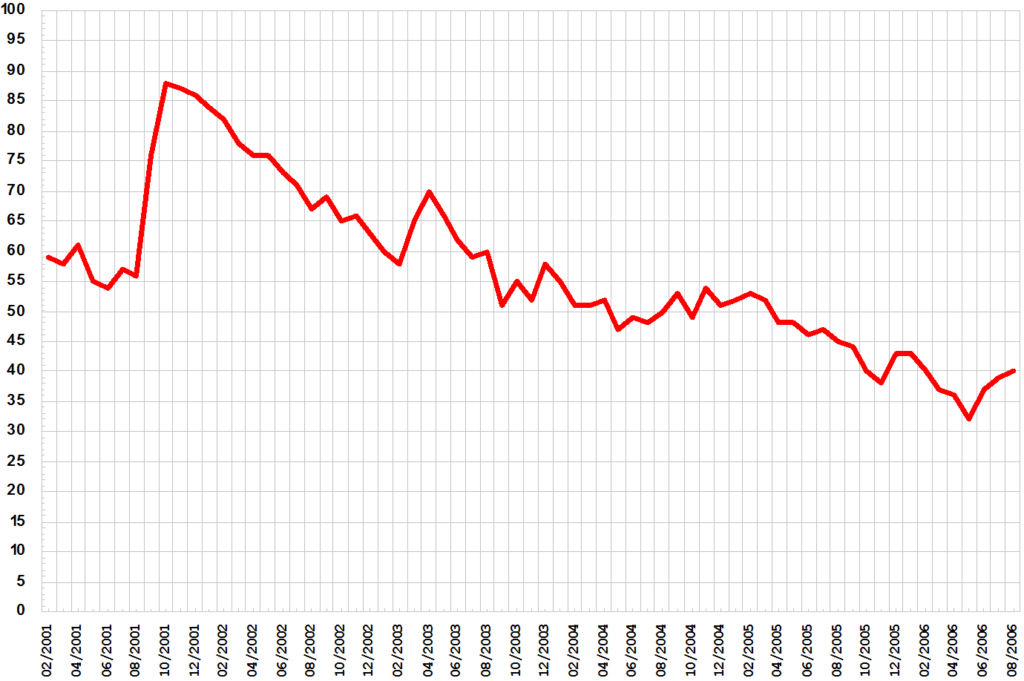
Line Charts are the most fundamental type of forex chart. They typically display the closing prices of currency pairings over a specific period, such as daily, weekly, or monthly.
Each closing price is connected by a straight line, resulting in a continuous line that provides a fundamental overview of price fluctuations. Even though line charts provide a clear view of long-term trends, they lack information on price fluctuations within each trading period.
Bar Charts
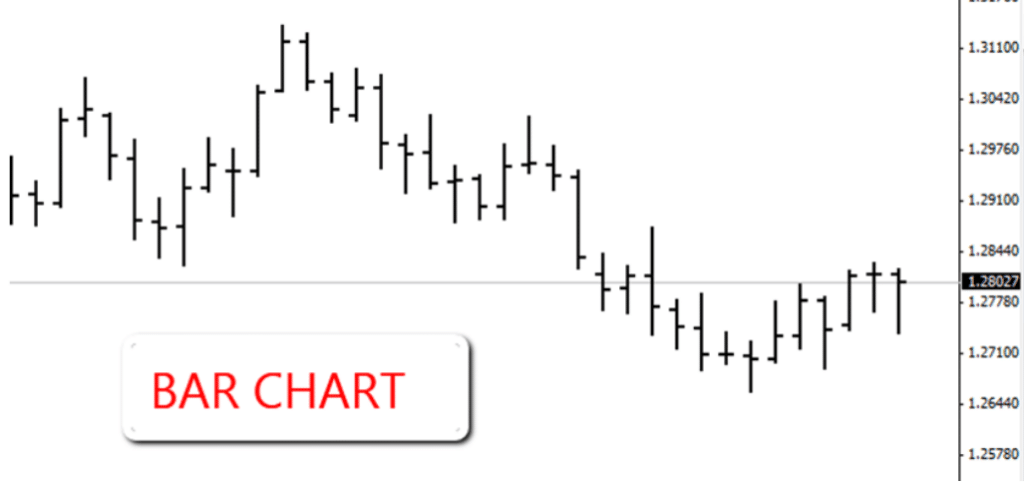
Compared to line charts, bar charts, known as OHLC (Open, High, Low, Close) charts, provide more comprehensive data.
Each bar on the chart represents a specific period and contains four points: the opening price (left side), the highest price achieved during the period (top), the lowest price reached (bottom), and the closing price (right side). Bar charts offer insight into the price range and volatility over a specific period.
Candlestick Charts

Like bar charts, candlestick charts display OHLC data for each period. Nonetheless, candlestick charts present the data in a more visually enticing manner.
Each period is represented by a candlestick, with the body of the candlestick representing the opening and closing prices and the wicks (or shadows) representing the period’s highest and lowest prices.
The popularity of candlestick charts among traders stems from their capacity to convey crucial information regarding market sentiment and price action.
Technical Indicators
Technical indicators are mathematical computations used by traders to forecast market changes in the future. They provide information on market trends, momentum, volatility, and strength, allowing traders to make more informed judgments.




Trend Analysis
Trend analysis studies the direction and strength of market movements to forecast future trends. Understanding trends is essential for profitable trading.






Support and Resistance Levels



Chart Patterns
Chart patterns are formations formed by a currency pair’s price fluctuations over time. Recognizing these trends can provide information regarding probable future price movements.




Effective Risk Management for Indonesian Forex Traders
The practice of detecting possible hazards and taking steps to mitigate their impact is known as risk management. Furthermore, it is a critical component of effective trading, particularly in the volatile Forex market.







Best Forex Strategies for Indonesian Traders Revealed

Best Forex Trading Strategies for Indonesians Forex trading strategies that have been revealed are critical for market success. They serve to guide trading decisions and manage risks. Here are some of the most effective tactics for Indonesian traders to use.
Trend Following Strategy



Swing Trading Strategy



Scalping Strategy



Breakout Strategy



Carry Trade Strategy



Spot, Forwards, and Futures in Forex Trading
Understanding the distinctions between spot, forwards, and futures in Forex trading enables traders to select the method that best meets their trading objectives and risk management requirements. We delve into these in the sections below.
Spot Forex Trading
Spot Forex trading is buying or selling a foreign currency for immediate delivery. The trade settlement, which includes exchanging currencies, typically occurs within two business days after the transaction date.
Spot trading is the fundamental and widely adopted approach to currency exchange among individual traders, corporations, and financial organizations.
This market boasts high liquidity levels, especially when dealing with major currency pairs, making it suitable for short-term trading strategies and urgent currency requirements.
Forwards Forex Trading
Forwards trading in Forex is entering into a contract to purchase or sell a particular amount of a currency pair at a predetermined price on a future date. Unlike spot trading, forward contracts are not standardized and can be tailored to the interests of the parties involved.
This modification enables businesses and investors to protect themselves against potentially negative currency swings by locking current exchange rates for future transactions.
Forward contracts manage future currency exposure, long-term investment plans, and currency risk. They are traded over the counter (OTC), meaning they are negotiated directly between the parties concerned without using an exchange.
Futures Forex Trading
Futures trading in Forex, like forward trading, is committing to purchase or sell a currency pair at a certain price on a specific future date. On the other hand, futures contracts are standardized and exchanged on exchanges, unlike forward contracts.
This standardization assures that all market players deal with the same contract terms, resulting in greater openness and regulation. Futures contracts frequently need a margin deposit to ensure both parties have the financial resources to fulfil the contract.
Futures trading is appropriate for speculative purposes, hedging, and portfolio diversification. Because of its transparency, liquidity, and flexibility to take long and short positions, it attracts diverse players, including individual traders, hedge funds, and institutional investors.
An Introduction to Forex Brokers

Forex brokers act as intermediaries between retail traders and the interbank foreign exchange market, facilitating access to global currency trading through their platforms, tools, and customer support.
Brokers play a vital role in executing forex trades efficiently while ensuring liquidity for traders and guiding them through the market’s intricacies. Below, we will explore a broker’s role and how they make money.
What is the Role of a Forex Broker?
Forex brokers perform various critical functions:




How do Forex Brokers Make Money?
Forex brokers earn money in a variety of ways:




Ask and Bid Price in Forex Trading
Ask and bid prices are fundamental concepts that play a significant role in every Forex transaction. They represent a currency pair’s selling and purchasing price and are fundamental to understanding how foreign exchange transactions function.
Ask Price
When trading in the foreign exchange market, a trader can buy a currency pair at its ask price, commonly called the “offer” price. The seller sets this rate and reflects their minimum selling price for that specific currency pair during that moment in time.
To assess how much it will cost them to acquire a particular currency pairing, traders analyze this offer price. It’s important to note that the offer price is consistently higher than the bid price, indicating sellers’ intent on making profits from these transactions
Bid Price
The offer price is the highest price buyers are willing to pay for a specific currency pair. When traders want to sell a currency pair, they consider this offer price as it indicates their potential profit.
It is worth noting that the bid price is always lower than the asking price since buyers aim to acquire the currency pair at its lowest feasible cost.
Spread and Pips in Forex Trading
Spread and pips are closely related concepts that further describe the Forex trading process.
Spread
As stated, the spread is the difference between the offer and bid prices of a currency pair. It is a direct expense incurred by traders when initiating and exiting trades.
Depending on market conditions, the spread can fluctuate throughout the trading day, and wider spreads typically indicate higher trading costs.
Understanding the spread is necessary for traders to compute potential profits and losses and select currency pairs and brokers compatible with their trading strategy.
Pips
In Forex trading, a pip is a standard measurement unit representing the slightest price movement that a currency pair can experience. A pip corresponds to the fourth decimal place (0.0001) for most currency pairings, but for Japanese yen pairs, it corresponds to the second decimal place (0.01).
Profit and loss in a trade are expressed in terms of pips. Understanding decimals enables traders to quantify price movements, set stop-loss and take-profit levels, and evaluate the effect of market volatility on positions.
An Introduction to Day Trading

Day trading is a style of trading that entails the purchase and sale of financial instruments within the same trading day. The objective is to profit from minute price fluctuations in highly liquid assets, such as currency pairs on the Forex market.
During a typical trading day, day traders execute multiple trades while intently monitoring price charts, economic news, and market trends.
Day trading requires fast decision-making, a thorough knowledge of the markets, and the ability to analyze short-term price fluctuations. Traders must constantly monitor the markets to identify opportunities and manage risks, necessitating a significant time commitment.
Rapid market fluctuations can result in significant losses, making risk management vital in day trading. Many day traders use stop-loss and take-profit orders to limit potential losses and secure profits. Leverage is commonly used to increase returns, but it also increases risk.
Day trading can be profitable, but it is commonly regarded as one of the most difficult trading strategies. It requires a solid trading plan, rigorous discipline, emotional control, and a willingness to invest time in ongoing study and practice.
Additionally, the high frequency of trades means that transaction costs, such as spreads and commissions, can accumulate and impact profitability.
An Introduction to Swing Trading

Swing trading is a trading strategy that seeks to profit from price “swings” or oscillations lasting several days to weeks. In contrast to day trading, where positions are terminated within the same day, swing traders hold positions overnight and frequently for days or weeks.
Swing trading is predicated on the notion that price fluctuations are not linear and that markets move in waves or shifts. Traders identify potential entry and exit points based on technical indicators, chart patterns, and sometimes fundamental analysis.
For swing trading, patience and an acute eye for identifying trends and reversals are required. Traders seek opportunities where they believe the market has temporarily overextended itself and is likely to retrace or continue its trend.
Risk management is essential in swing trading, and stop-loss and take-profit orders are frequently used to secure positions. In contrast to day trading, leverage is typically implemented more conservatively in long-term investing.
Swing trading balances day trading’s rapid tempo and position trading’s longer-term approach.
It is appropriate for those who cannot monitor the markets continuously but still wish to trade actively. It requires knowledge of technical analysis and market trends and the patience to allow transactions to play out over time.
The Importance of Market Sentiment in Forex Trading
The sentiment of investors and traders towards a particular asset or the market is called market sentiment. In foreign exchange trading, market sentiment can substantially impact currency price fluctuations.
Economic indicators, political events, news, and other factors that influence traders’ perceptions of supply and demand influence market sentiment.
For instance, positive economic data can result in bullish sentiment, which can cause a currency to appreciate. In contrast, political uncertainty can result in pessimistic sentiment, which can cause a currency to depreciate.
Traders frequently analyze market sentiment utilizing a variety of instruments, including sentiment indicators, surveys, and Commitment of Traders (COT) reports.
Understanding market sentiment enables traders to discern the potential direction of currency movements, identify reversals, and formulate strategies per prevalent market attitudes.
However, market sentiment can be volatile and rapidly changing, particularly in response to unexpected news or events.
Incorporating sentiment analysis into a comprehensive trading strategy, in addition to technical and fundamental analysis, can provide a more comprehensive perspective of the market.
MetaTrader 4 VS MetaTrader 5
| Features | MetaTrader 4 | MetaTrader 5 |
| 📊 Market Focus | Primarily Forex | Multi-asset |
| 💻 User Interface | Simpler, user-friendly | More complex, advanced |
| ⏰ Timeframes | 9 | 21 |
| 💰 Order Types | 3 | 6 |
| 👥 Technical Indicators | 30 | 38 |
| 🌐 Graphical Objects | 31 | 44 |
| 📉 Automated Trading | Yes (EAs) | Yes (EAs with built-in tester) |
| 📚 Programming Language | MQL4 | MQL5 |
| ⬆️ Market Depth | No | Yes |
| 💸 Hedging | Yes | Yes (added later) |
Best Forex Brokers in Indonesia
Best MetaTrader 4 / MT4 Forex Broker in Indonesia
Min Deposit
0 USD / 0 IDR
Regulators
FSCA, CySEC, DFSA, FSA, FCA, FSC, CMA
Trading Desk
MetaTrader 5, MetaTrader 4, HFM App
Crypto
Total Pairs
50+
Islamic Account
Trading Fees
Account Activation
Overall, HFM is the best MT4 Forex Broker in Indonesia. HFM is a popular broker in Indonesia, where traders may use MetaTrader 4 and trade in one thousand different CFDs. As a result, traders can take advantage of competitively cheap costs and tight spreads.
Best MetaTrader 5 / MT5 Forex Broker in Indonesia
Min Deposit
10 USD / 157,151 IDR
Regulators
FSC, FSA, FSCA
Trading Desk
MetaTrader 4, MetaTrader 5, BDSwiss Mobile App, BDSwiss Webtrader
Crypto
Total Pairs
83
Islamic Account
Trading Fees
Account Activation
Overall, BDSwiss is the best MetaTrader 5 Forex Broker in Indonesia. On the MT5 platform provided by BDSwiss, traders of CFDs are free to employ any strategy they see fit.
For Indonesian traders of all experience levels, BDSwiss provides access to their extensive library of research, educational, and trading tools.
Best Forex Broker for Beginners in Indonesia
Min Deposit
0 USD / 0 IDR
Regulators
FCA, BaFin CySEC, FINMA, DFSA, FSCA, MAS, JFSA, ASIC, FMA, CFTC, NFA, BMA
Trading Desk
MetaTrader 4, IG Platform, ProRealTime (PRT), L2 Dealer, FIX API
Crypto
Total Pairs
80
Islamic Account
Trading Fees
Account Activation
Overall, IG is the best Forex Broker for beginners in Indonesia. IG provides various services to help traders of all skill levels, such as trading tools and educational content. Indonesians can also register a free demo account to practice trading and test strategies.
Best Low Minimum Deposit Forex Broker in Indonesia
Min Deposit
10 USD / 157,151 IDR
Regulators
CySec, FSC
Trading Desk
MT4, MT5, Mobile Trading
Crypto
Total Pairs
60+
Islamic Account
Trading Fees
Account Activation
Overall, FXTM is the best Low Minimum Deposit Forex Broker in Indonesia. An Indonesian can open an FXTM trading account for as little as 150,000 IDR ($10). Furthermore, FXTM provides secure deposit and withdrawal options using trusted payment processors.
Best ECN Forex Broker in Indonesia
Min Deposit
25 USD / 392,878 IDR
Regulators
CySEC, SVG, FSA
Trading Desk
MT4, MT5, OctaTrader
Crypto
Total Pairs
28
Islamic Account
Trading Fees
Account Activation
Overall, OctaFX is the best ECN Forex Broker in Indonesia. The finest liquidity providers’ prices are used by OctaFX, an NDD broker that offers STP and ECN execution. This means that the minimum spread on major currency pairs (such as the EUR/USD) should be zero pips on all exchanges.
Best Islamic / Swap-Free Forex Broker in Indonesia
Min Deposit
200 USD / 3,143,030 IDR
Regulators
CySEC, FCA, ASIC, FSA, NFA, FinCEN, FINRA, SIPC
Trading Desk
eToro proprietary platform
Crypto
Total Pairs
40+
Islamic Account
Trading Fees
Account Activation
Overall, eToro is the best Islamic / swap-free Forex Broker in Indonesia. eToro provides access to about 3,000 financial products across various asset types (equities, cryptocurrencies, etc.).
Muslims can avoid exchange costs while trading halal instruments by changing their live accounts to the eToro Islamic option.
Best Rebates Broker in Indonesia
Min Deposit
10 USD / 157,151 IDR
Regulators
CBCS, CySEC, FCA, FSA, FSC, FSCA, CMA
Trading Desk
MetaTrader mobile, Exness Trade App, Exness Terminal, MetaTrader 5, MetaTrader 4, MetaTrader WebTerminal
Crypto
Total Pairs
107
Islamic Account
Trading Fees
Account Activation
Overall, Exness is the Best CFD Rebates Broker in Indonesia. Indonesians can take advantage of rebates up to 100 per lot, or 20% of the spread when opening a Standard, Standard Cent, Raw Spread, or Zero Account with Exness.
Best IDR Trading Account Forex Broker in Indonesia
Min Deposit
1 USD / 15,715 IDR
Regulators
None
Trading Desk
MetaTrader 4, SuperForex App
Crypto
Total Pairs
300
Islamic Account
Trading Fees
Account Activation
Overall, SuperForex is the best IDR Trading Account Forex Broker in Indonesia. Indonesian traders can register a Swap-Free Account with SuperForex, allowing them to trade using IDR as their account base currency. Furthermore, traders have access to local payment options in IDR.
Best Lowest Spread Forex Broker in Indonesia
Min Deposit
0 USD / 0 IDR
Regulators
ASIC, BaFin, CMA, CySEC, DFSA, FCA, SCB
Trading Desk
MetaTrader 4, MetaTrader 5, cTrader, TradingView
Crypto
Total Pairs
60+
Islamic Account
Trading Fees
Account Activation
Overall, Pepperstone is the best lowest spread Forex Broker in Indonesia. Pepperstone is a popular CFD broker offering traders various instruments with spreads as low as 0 pip on the most traded pairs.
Technical and fundamental assessments can be conducted with Pepperstone’s many trading tools and specialized learning sites.
Best Nasdaq 100 Forex Broker in Indonesia
Min Deposit
10 USD / 157,151 IDR
Regulators
Cyprus, CySEC
Trading Desk
Libertex mobile, MT4, MT5
Crypto
Total Pairs
50+
Islamic Account
No
Trading Fees
Account Activation
Overall, Libertex is the best Nasdaq 100 CFD Broker in Indonesia. Libertex offers 0 pip spreads on the Nasdaq 100 and other indexes. Nasdaq trading is also possible on state-of-the-art platforms, including Libertex, MetaTrader 4, and MetaTrader 5.
Best Volatility 75 / VIX 75 Forex Broker in Indonesia
Min Deposit
100 USD / 1,571,515 IDR
Regulators
ASIC, FSA, CBI, BVI, FSCA, FRSA, CYCES, ISA, JFSA
Trading Desk
MetaTrader 4, MetaTrader 5, Ava Social, Ava Protect, Trading Central
Crypto
Total Pairs
55+
Islamic Account
Trading Fees
Account Activation
Overall, AvaTrade is Indonesia’s best Volatility 75 / VIX 75 Forex Broker. Regarding the VIX 75 index as a CFD instrument, AvaTrade gives Indonesian retail traders a leverage of up to 1:20, with spreads from 0.15%.
Best NDD Forex Broker in Indonesia
Min Deposit
100 USD / 1,571,515 IDR
Regulators
ASIC, CySEC, FSCA, FSA
Trading Desk
MetaTrader 4, MetaTrader 5, Myfxbook AutoTrade, FP Markets App
Crypto
Total Pairs
70+
Islamic Account
Trading Fees
Account Activation
Overall, FP Markets is the best NDD Forex Broker in Indonesia. Regarding NDD brokers, FP Markets is the best option for scalpers, hedgers, and automated traders.
In addition to low commission rates ($3–$3.5 per trade), FP Markets provides competitively low spreads on ECN execution.
Frequently Asked Questions
What is Forex trading in Indonesia?
In Indonesia, forex trading entails buying and selling foreign currencies. Furthermore, the Commodity Futures Trading Regulatory Agency regulates this popular investment activity.
Are Forex brokers regulated in Indonesia?
Local forex brokers are regulated by the Commodity Futures Trading Regulatory Agency (BAPPEBTI), while this entity does not regulate international brokers. Therefore, traders must ensure their broker has regulations with reputable entities such as FSCA, CySEC, FCA, etc.
Can I trade Forex with IDR?
No, you cannot. IDR is not currently tradable due to several reasons that are not given. However, in our experience, exotic currencies are often not traded internationally because of low liquidity and high risk or regulations and restrictions.
What are the best Forex brokers in Indonesia?
Exness, Pepperstone, AvaTrade, HFM, and other forex brokers are the best options for Indonesian traders.
How can I start Forex trading in Indonesia?
To begin Forex trading in Indonesia, select a regulated broker, open a trading account, deposit funds, and execute transactions using the trading interface.
What are the popular trading pairs in Indonesia?
EUR/USD, GBP/USD, AUD/USD, and other forex pairs are extremely popular in Indonesia.
Is leverage allowed in Forex trading in Indonesia?
Yes, leverage is permitted in Indonesian Forex trading, although it may be subject to limitations and regulations imposed by the broker and regulatory authorities.
What strategies can Indonesian Forex traders use?
Depending on their trading goals, risk tolerance, and market conditions, Indonesian Forex traders might apply various methods, including trend following, swing trading, scalping, and technical analysis.

 Best Forex Brokers in Indonesia
Best Forex Brokers in Indonesia


 Scam Forex Brokers in Indonesia
Scam Forex Brokers in Indonesia
